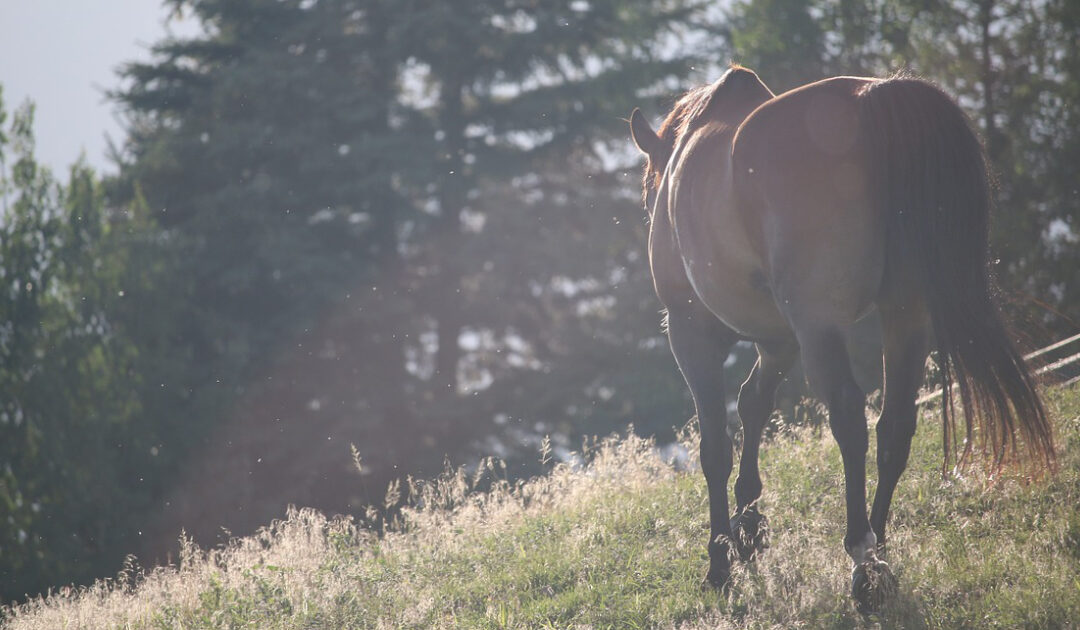
by Bettina Shultz-Jobe, LPC, NBCC | May 7, 2021 | Equine Assisted Trainings, The Latest in Equine Assisted Therapy and Learning
The recent global pandemic forced us to. . .
Pause.
Reflect. Connect. Cry a little (or a lot depending on the day!). Curse a bit (okay, so maybe a lot some days!).
Pause and reflect and connect some more. . .
Then evolve.
Okay, so I can only speak for myself when I say that the Pandemic resulted in a decent amount of “curse crying” – a coping mechanism I don’t necessarily recommend, professionally speaking, but do, personally, find quite effective at times. Truly though, this transformation was at times painful for the entire NL team. Even though the caterpillar’s story of transformation and loss was already near and dear to my heart, I now have a more embodied understanding of the plight of the butterfly.
All of this said, the pause, the reflection, the connection (and the blood, sweat, and tears. . . AND cursing!) allowed us to soar to new heights—and inspired us to adapt our teachings, trainings, and events to allow for transformative change in the larger Equine Assisted Services (EAS) community.
At Natural Lifemanship, we are designing a better way to equip students with the knowledge, skills, and experiences necessary for deep healing—allowing for greater access that meets each student where they are.
Looking back…
We were, and are proud of the progress we have helped to make in the field of Equine Assisted Services (EAS). In finding unique and powerful ways of working with clients and horses based on principles of connection and healthy relating, over ten years ago my husband, Tim Jobe, and I chose to begin equipping other professionals to expand the reach of EAS’s potential for healing.
The world could benefit from more practitioners in the field—we recognized this.
After 10 years of guided in-person trainings, we faced an unforeseeable obstacle. A global pandemic. With just days notice, people throughout the world found themselves indoors, and travel and in-person meetings came to an abrupt end. As the need for support, healing, growth, and wellness grew, so too did the possibility our doors would remain closed for good. (Hence the aforementioned tears and cursing!)
This was not an option for us!
Our little field offers some of the safest and most effective trauma treatment available. Period. People needed competent, connected, and impassioned practitioners more than ever.
MORE THAN EVER.
And mental health professionals, equine professionals, and others in the healing professions needed more support than ever!
MORE THAN EVER!
Moving forward…
After reflecting on the needs of our clients and students, we chose to make our trainings accessible from home. We redesigned our popular *TF-EAP and **TI-EAL based Fundamentals training to be taken virtually, but with a personalized experience that provided guided feedback, one-on-one meetings, and experiential learning. All of which could be completed from home.
To our delight…we found that we were able to provide more content, more resources, and more guidance than ever before. The results showed that many of our students not only thrived, but preferred the virtual fundamentals over our previous in-person training.
In 2020 we also started a scholarship fund and in 2021 we have awarded over $16,000 in scholarships and hope to award more as the year progresses! We are seriously committed to making our trainings as accessible as possible!
*Trauma Focused Equine Assisted Psychotherapy
**Trauma Informed Equine Assisted Learning
Our New & Better Normal
Our greatest challenge in redesigning our trainings was the recognition that we needed to provide various options for the unique needs of our students. We believed that a temporary solution, such as a few online courses, would not provide students with the in-depth education they needed and deserved.
If we were to ensure that our students were fully prepared to work with clients in an EAS setting, we needed to think big—and we did.
Our team came together and designed the most extensive EAS (Equine Assisted Services) training available, with the option of FULLY completing the program from home.
Fundamentals of Natural Lifemanship—Redesigned
Prior to Covid, our Fundamentals of NL training was impactful in that it allowed our students to gain the foundational knowledge and skills needed to engage in the EAP/L process—using the principles of Natural Lifemanship. Actually, I know I’m biased, but our pre-pandemic trainings were excellent!
It’s just that post-pandemic they’re EVEN BETTER!
Today, the Fundamentals of NL training is so much more extensive. We’ve created an 8-week curriculum that dives much deeper into the science of trauma, attachment, and somatics, and provides an immense amount of content that simply can’t be covered, digested, and embodied during a two or three day in-person training.
Nowadays, IF you choose to do in-person training with us (more on this below) you get significantly more time doing the stuff that simply can’t be done online – building nuanced relationship with horses. More time online means more time to experience the power of the horse-human relationship. More time online means that when you come to us you are WAY better prepared to get busy and do some experiencing!
What’s more? Even online we are still able to give individualized guidance and experiential learning exercises that we review for feedback. Students benefit from taking the training in group settings, and interacting with one another—as well as the convenience of working from home with their own horses.
Given that each student has a unique set of circumstances, we provide the following training paths:
The Foundational Fundamentals is a comprehensive introduction to NL for those who may not have access to horses, will not be pursuing certification, or prefer to complete their experiential work in-person by adding on the Fundamentals Practicum, which is our in-person training experience. This is a great option for those who are completely new to Natural Lifemanship or need a refresher.
The Core Fundamentals is designed for people who have access to horses and who want to be able to say they are NL Level 1 trained. In taking this training, students move closer to completing NL certification.
Our Certification Jumpstart option allows students to jumpstart the certification process. Not only does this training count toward some of the certification requirements, it also comes with a bundle deal including a one-year NL professional membership, certification enrollment fee, two personal face-to-face consultations on Zoom––all of which are required for certification. This is the greatest bang for the buck if you know you want to get certified in NL.
What about the hands-on experience?
We fully understand the importance of providing an experiential component to our trainings. After all, what good is a practitioner who has yet to practice? We knew it would be a challenge to create a hands-on learning experience that could be completed from home. . . so we came up with the following solutions—and we couldn’t be happier.
Here are the THREE ways to complete the experiential work required for those seeking certification or wishing to claim that they are NL Level 1 trained. They are. . .
The At Home Experience in which students complete several video assignments and receive feedback and guidance from NL trainers. This experience does require that students have access to a horse.
The In-Person Experience in which students attend one of many in-person practicums throughout the United States and practice their skills and knowledge with in-the-moment guided feedback from our experienced and intuitive NL trainers. (Students must attend the Fundamentals of NL prior to attending)
Or you can do a combination of the two—for those who really want to dive deep and get all of the experience possible.
Our In-Person Practicum
We understand that many people in our field prefer an intimate and interactive in-person training environment so we designed the Fundamentals Practicum to be an unforgettable training experience that allows students to build on their virtual learning experience through hands-on work utilizing the Natural Lifemanship principles. Most of the didactic learning is done online in the Fundamentals of NL leaving significantly more time and space to truly embody the knowledge and skills gained.
We are currently offering several Fundamentals Practicums throughout the year that are hosted at our partner sites scattered throughout the country, making this experience more accessible for everyone.
By the way, in 2021 we adopted the same training structure for our NL Intensive training making it possible to get fully certified in NL from home! The NL Intensive is virtual. There are two options to meet your needs: Foundational Intensive and Core Intensive. The experiential portion of the Intensive training can be done at home or in-person at an Intensive Practicum.
At Natural Lifemanship, we believe that leading means innovating, inspiring, adapting, and evolving—to meet the needs of our compassionate and impactful students as well as our communities, who are in need of deep healing.
While our trainings have evolved to better meet your needs, our principles remain the same. Every training experience through Natural Lifemanship continues to be centered around building healthy relationships and deep connections, based on mutual trust and respect—for EAS practitioners, clients, and horses.
Learn more by watching our latest webinar, “Our New and Better Normal.”
Learn more about the Natural Lifemanship way…
#1 Take some of our courses. We offer many low cost, single purchase courses and videos for those just wanting to get an idea of what’s out there. Many of our courses offer CE credits through NBCC and NAADAC. Many courses are also part of NL Membership or can be purchased by members at steep discounts. Check out our courses here.
#2 Follow along for FREE! We offer an array of free content online through webinars, blogs, and videos – you can do any or all of the following to stay connected and up to date on NL happenings!
- Visit our website naturallifemanship.com to explore blogs and other content. Seriously, so much can be gleaned from our blogs!
- Sign up for a free introductory membership and gain access to educational videos and a new free video each month.
- Subscribe to our newsletter to be notified of news, blogs, trainings, etc.
- Like and Follow our Facebook page and Instagram – we share videos, pictures, articles, and engage in thoughtful discussions.
- The Trauma Focused Equine Assisted Psychotherapy Networking Group on Facebook is also a valuable resource. This group is managed by NL trainers, but is open to ALL. Such great conversations happen in this group!
- Follow our YouTube Channel for free video content! This is a great place to begin understanding how the relationship between horse and person progresses, organically and over time, utilizing NL principles. Watch this video first and then follow the progress made with Annie and Abilene.
We look forward to supporting you as you grow professionally and heal personally—so you can support others.
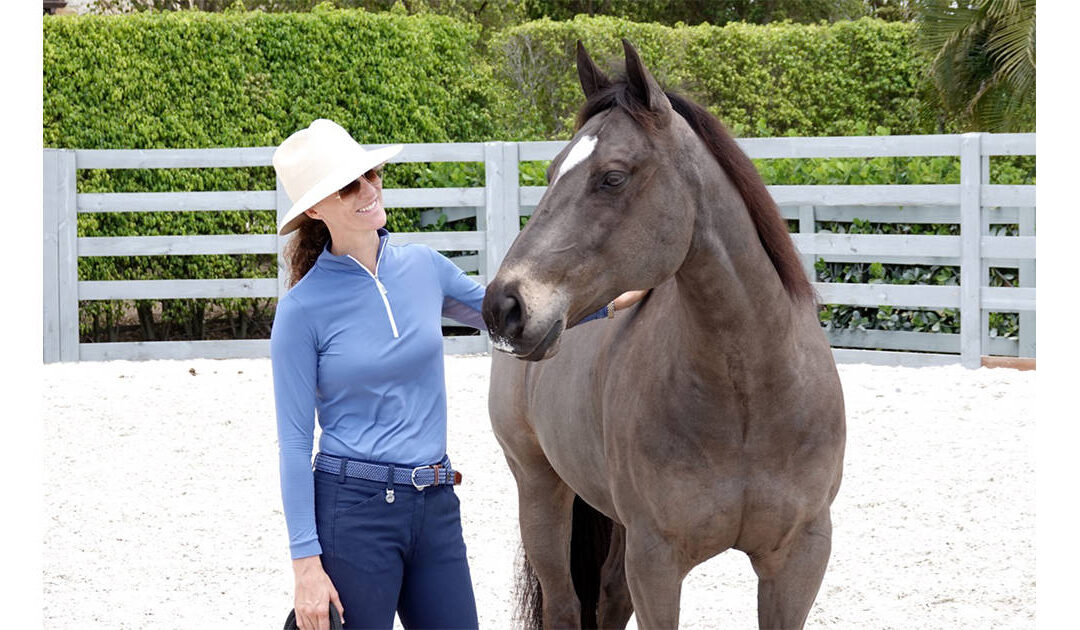
by Sarah Willeman | Aug 20, 2018 | Basics of Natural Lifemanship, Equine Assisted Trainings, Testimonials & Reflections
By Sarah Willeman
Building Connected Relationships
Horse-assisted psychotherapies show tremendous promise in helping people with trauma, which is notoriously difficult to treat. Trauma lives not only in our conscious mind but deeper in our nervous system, in parts of the brain responsible for basic survival. We can’t will our way—or talk our way—out of it. Horses can help people regulate those deeper brain regions. Recently I attended a training in one particular therapy model that’s captured my attention. It’s based on healing through connected relationships, beginning with the horse.
The Model
The model is called Natural Lifemanship. I found the name corny at first, but now I get it. Beyond just therapy, this is a way of being in the world—a guiding mindset for building relationships in all areas, with people and animals. The Natural Lifemanship school of therapy is called Trauma-Focused Equine-Assisted Psychotherapy (TF-EAP). It’s based on the structure and function of the brain, and it combines neurobiology with sound relationship principles. People learn these principles in the context of their relationship with the horse and can then transfer them to other relationships in their lives.
The founders, Bettina Shultz-Jobe and Tim Jobe, have backgrounds in psychotherapy with at-risk groups and horsemanship with challenging cases, like wild mustangs. (In his job starting mustangs, Tim could take a horse never before touched by a person and be riding him in a couple of hours—and not through coercive techniques.) In other words, the founders have deep expertise with both horses and psychology. And the method goes far beyond just that “magical” quality that contact with horses can have. This work has clear principles, organization, and purpose and has helped a lot of people.
The Neurobiology
A horse’s brain works in similar ways to that of a traumatized person: the lower, survival-focused brain regions are largely running the show.
The Equine Brain
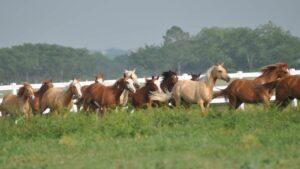
Horses’ brains are naturally built this way. Compared to humans, horses have a small neocortex, the region responsible for thinking. In herd life, only the lead mare needs to do much thinking. Horses mainly need their fight-or-flight reflexes, and they need to follow the herd. Survival is the horse’s essential skill, and it’s governed by the lower brain.
The Human Brain in Trauma
With trauma, a person becomes stuck in those same lower brain regions. The fight-or-flight response actually has a third component: it’s fight, flight, or freeze. When a person is stuck in these states, the survival regions of the brain get over-exercised, the nervous system becomes dysregulated, and the person has trouble regaining internal calm—the calm that’s necessary for good relationships and physical wellbeing.
That over-exercising of the lower brain leads to two things, anatomically: it builds up the lower brain and simultaneously sacrifices connections to the upper brain regions, where thinking and emotional connection happen. There’s a use-it-or-lose-it phenomenon with brain pathways. A traumatized person has trouble with self-regulation because many of the cross-brain connections that allow us to consciously calm our survival reflexes have been lost—or in the case of childhood trauma, perhaps never created.
Healing the Brain
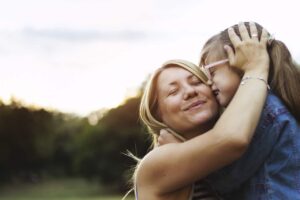
The good news is the brain has plasticity, and new connections can be formed. The most effective trauma therapy will first regulate the lower brain and then engage the upper brain regions, thereby forming new pathways, helping all parts of the brain to integrate with each other for healthy functioning.
In Natural Lifemanship, it’s crucial to understand which part of the brain a horse or person is responding or reacting from. (Responding is associated with calm, integrated thinking; reacting is habitual and reflexive.) This understanding is important because if someone’s in survival mode and you try to reason with their thinking brain, they’re simply not there to receive what you have to say.
Horses demonstrate this phenomenon. A scared horse cannot learn. The best horsemen understand that training through intimidation will ultimately fail. The horse might robotically comply out of fear, but he’ll eventually make a panicked mistake, or try to run away from the rider’s signals, or become injured from the constant stress. But a horse in a calm, connected state can develop and flourish.
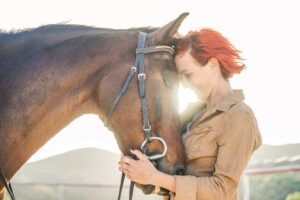
And here’s what gives rise to a powerful road to healing: humans and horses are born with an innate desire to connect.
We want to form safe, caring bonds with other beings; we yearn for experiences of trust and mutual understanding. In fact, as psychology’s well-established field of Attachment Theory teaches, we need those safe connections in order to have a healthy nervous system. Natural Lifemanship uses the power of emotional connection to heal and integrate the brain of both human and horse.
How Natural Lifemanship Works
Although the principles can be applied in any setting, the primary mode of TF-EAP is working with horses in the round pen.
The person gradually builds a healthy, connected relationship with the horse by learning to make requests of the horse, recognize the horse’s signals, and respond appropriately.
This process requires the person to become aware of her internal state, which the horse instinctually senses. (You could do the same outward gestures with different internal states and get a completely different reaction from the horse.) Throughout the work, the therapist and horse together help the person develop self-awareness and self-regulation, as new neural pathways are formed.
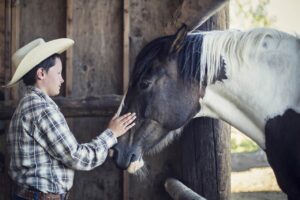
If the person’s nervous system is too agitated, the therapist can use specific techniques to calm those lower brain regions. Certain types of sensory input and movement—namely, rhythmic and repetitive—have been found to regulate and soothe the nervous system. (Think of a steady heartbeat or rocking a baby.) TF-EAP therapists use a variety of proven methods to help the client regulate her brain from the bottom up; in other words, beginning with the lowest brain region that needs support. The survival-focused brainstem has to settle before higher brain regions like the limbic system and neocortex can be engaged in relationship-building activities.
The Horse-Human Relationship
A connected relationship is one in which both parties choose to do what’s right for the relationship, and those choices are made freely and willingly.
In Natural Lifemanship, the relationship with the horse is not a metaphor or proxy for a human relationship; rather, it’s a real relationship. Although there’s apparent overlap with many schools of Natural Horsemanship, there are important differences, too. Instead of viewing the human as the horse’s leader and asking the horse to be submissive, Natural Lifemanship seeks a dynamic of mutual respect and trust, with self-regulation and good decision-making on both sides. The horse learns to pause, think and freely choose to do the right thing.
This key conceptual difference arises from the model’s basis in neurobiology. Just as a human can develop new neural pathways, a horse can, too. Interactions with humans offer a unique opportunity to actually build up the horse’s neocortex (and capacity for self-regulation) in a way that wouldn’t happen in herd life.
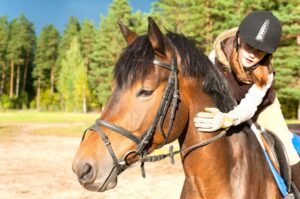
And because horses are so direct—their responses are immediate and honest—they provide excellent feedback for the person. Horses sense how we really feel. Communication is visceral and genuine. When it goes well, there is a simple, genuine pleasure. Connection is inherently rewarding for both human and horse.
As human and horse begin to co-regulate, they help each others’ nervous systems become calm, integrated and functional. And that quality of mutual benefit is essential for true connection and healing. Natural Lifemanship teaches a profoundly empowering skill: how to develop a strong relationship that’s good for both parties.
These are two key principles:
- “If it’s not good for both, it’s eventually not good for either.”
- “Regardless of the task or activity, connection is always the goal.”
These principles can be applied to work with horses and to all relationships with people and animals.
Compliance Versus Cooperation
In order to create connection, we need to understand the difference between compliance and cooperation. Compliance is a submissive action; it’s reflexive and robotic, arising from the lower brain’s survival instinct. On the other hand, cooperation is willing and freely chosen, arising from an integrated, whole-brain process in which the horse calmly figures out what to do.
So how do we tell the difference?
Well, it can be hard, because both can lead temporarily to very similar outward behaviors. Certainly, there are emotional cues, which can be subtle. But the real answer lies in the process.
Asking For Connection
As Natural Lifemanship explains, “Connection is predicated on a request.” In other words, rather than waiting for connection to magically happen, we need to ask for it. And how we ask—or how strongly we ask—has a major impact on the horse’s (or person’s) response.
The teaching is this: neither placate nor coerce. Both those extremes will eventually lead to aggressive behavior from the horse. (And as we talk about the horse here, continue to think of parallels with people.) Between those extremes lies the powerful zone of growth and connection.
An essential part of the process in TF-EAP is learning to make requests in an authoritative, calm manner, using the appropriate amount of pressure.
The Pressure Continuum
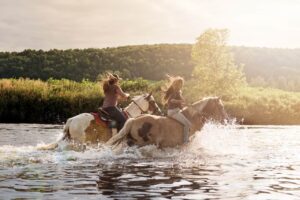
In this context, pressure is not a bad thing but just a fact of the universe. Making a request is a form of pressure. The goal is to use the least amount of pressure necessary.
Too little pressure and we’ll get ignored. Too much pressure and we’ll get fight-or-flight-type reactivity. Imagine an example: if someone yells at you when you’d’ve been happy to listen to a kind request, you might be mad (fight) or scared (flight) or too startled to know what to do (freeze).
Similarly, too much pressure can scare or anger a horse. If he’s in this state and still complies with our immediate request, he’s in his survival brain. This is not freely-chosen cooperation, and it’s not connection.
The appropriate amount of pressure compels the horse to search for an answer but leaves his options open, so he can figure it out and make a voluntary choice. This is the sweet spot of learning and relationship-building.
When we make a request of the horse, he can do one of three things: ignore, resist or cooperate. Herein lies one of the most powerful insights of the work: resistance is not necessarily bad. It means he’s trying to find an answer.
If he tries some wrong answers, we just keep the pressure the same. In order to do so, we need to stay calm and maintain control of our body energy, which can be hard to do when we’re not getting what we want. (Master horsewoman Sarah Dawson described this phenomenon during foal training: “I have to be careful I don’t take offense to any of the wrong answers he tries. He’s just trying to figure it out.”) We need self-awareness and self-regulation in order to succeed at this step.
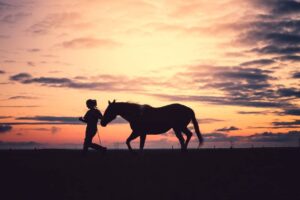
Then—and this is equally crucial—when the horse begins to find the right answer, we immediately release the pressure. Which probably sounds familiar; the timing of pressure and release is the most fundamental skill of horse training. But you’d be surprised how often people mess this up, with horses and with other humans.
In the Round Pen
So, what does all this look like in the round pen?
With the horse lose in the pen, we apply pressure by raising the energy of our body and directing that energy—movement, sound, internal state—toward the horse.
We might lift our arm or swing a rope; cluck or make other sounds; walk more energetically or, at the extreme end, stomp our feet. Depending on the sensitivity of the horse, we could get a response from just a small shift in our energy. The specific direction of our energy is crucial, beginning with the direction of our gaze.
And an important note: we need to learn to raise our energy while maintaining a state of calm. Energy and agitation are not the same thing.
In the following series of photos, I’m working with Cruz on attachment, which is a central part of the method. In this case, attachment means I’m asking him to follow me. Here’s what to look for:
The Request
To ask Cruz for attachment, I apply pressure to his hindquarters. (Another difference from typical horse training, which drives the horse forward from the hindquarters. Here, to ask him to move forward I’d apply pressure near the girth region, where my leg would be if I were riding.) To begin with the least amount of pressure, I simply look at his hindquarters, with my torso pointing toward that part of his body. If necessary, I can increase my body energy and movement from there.
The Release
I want him to turn his attention toward me and begin to move in my direction, so those are the things I reward by releasing pressure—specifically, by lowering my body energy/movement/gestures, backing away, softening my voice, or actually turning and walking away. I don’t reward submissive gestures like dropping his head and licking his lips. If he does those things after I’ve released the pressure, that’s all right; it’s a sign of relaxation (along with yawning, sighing or snorting in that particular relaxed horsey way). But if he does those things in response to pressure, it’s a reflexive, lower-brain attempt at submission, which we don’t want.
The Connection
When he attaches and follows me, I let myself really feel the enjoyment of it—which he senses and enjoys as well.
So let’s begin…
Cruz ignores the subtler signals, so I kiss to him and swing the rope to help me raise my body energy: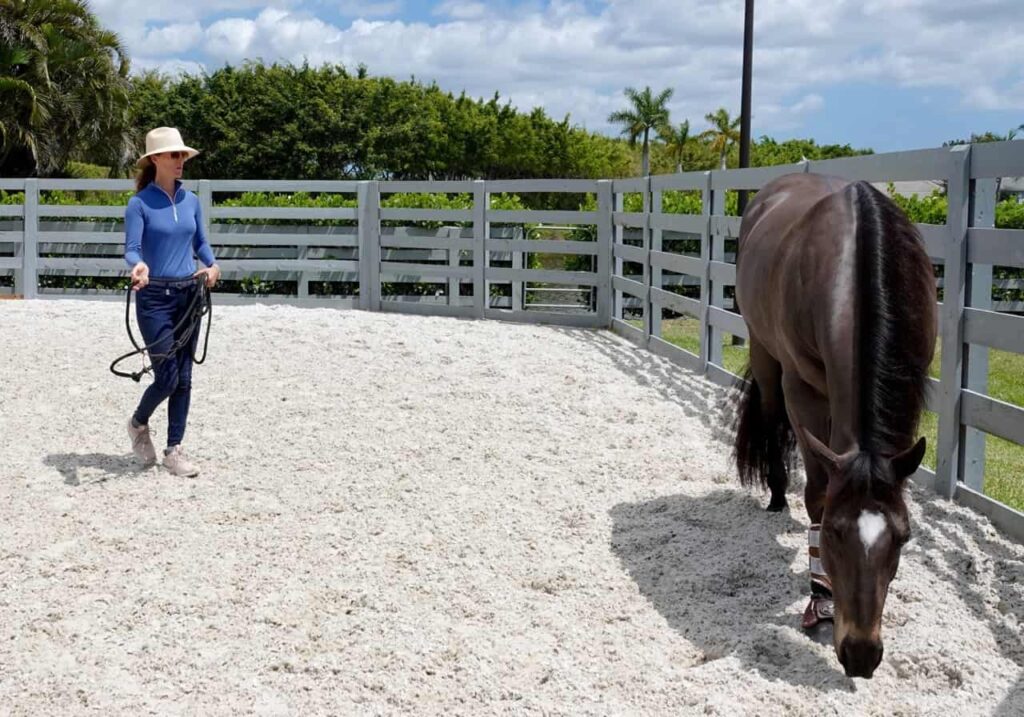
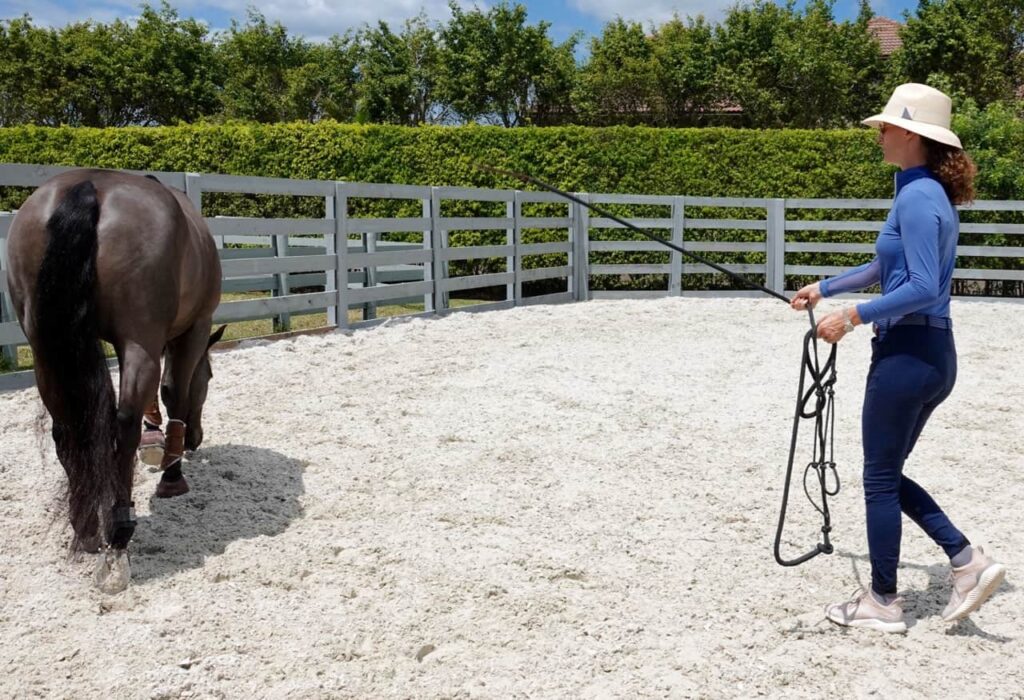
He searches for an answer by trotting away, but since that’s not what I’m asking, I keep the pressure the same:
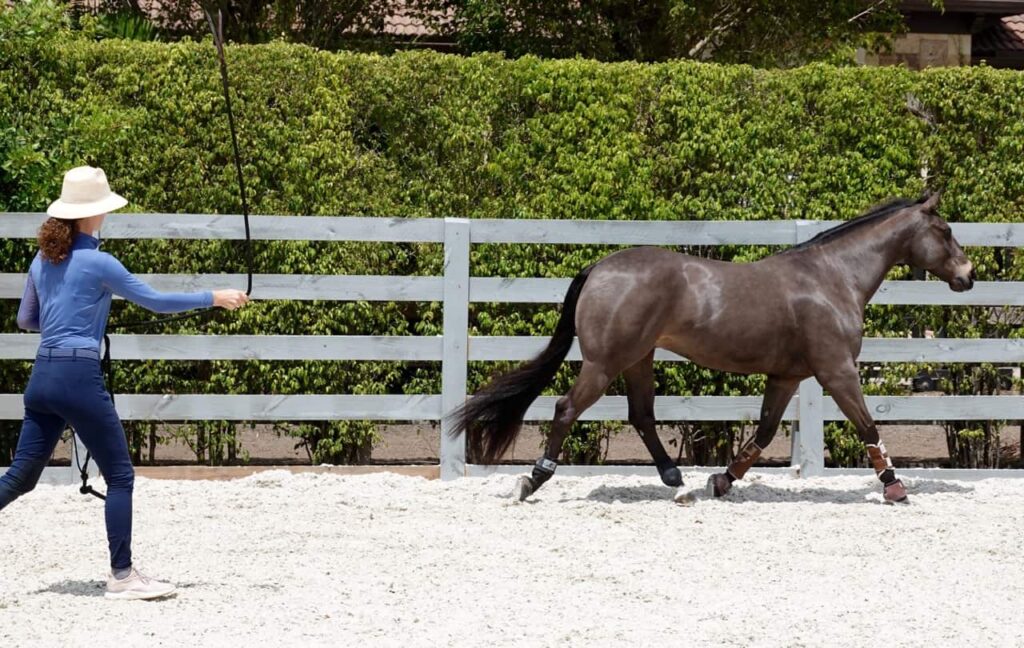
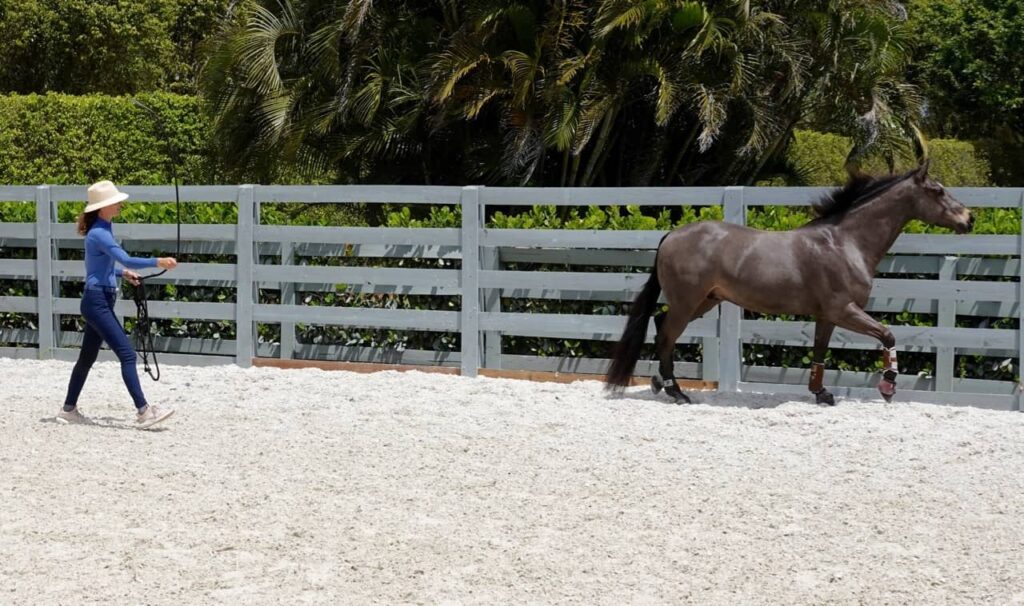
As soon as he starts to slow down and shift his attention toward me, I lower the rope and back away. He walks toward me; I release further by turning and walking away, allowing this sense of connection to soothe my own nervous system:
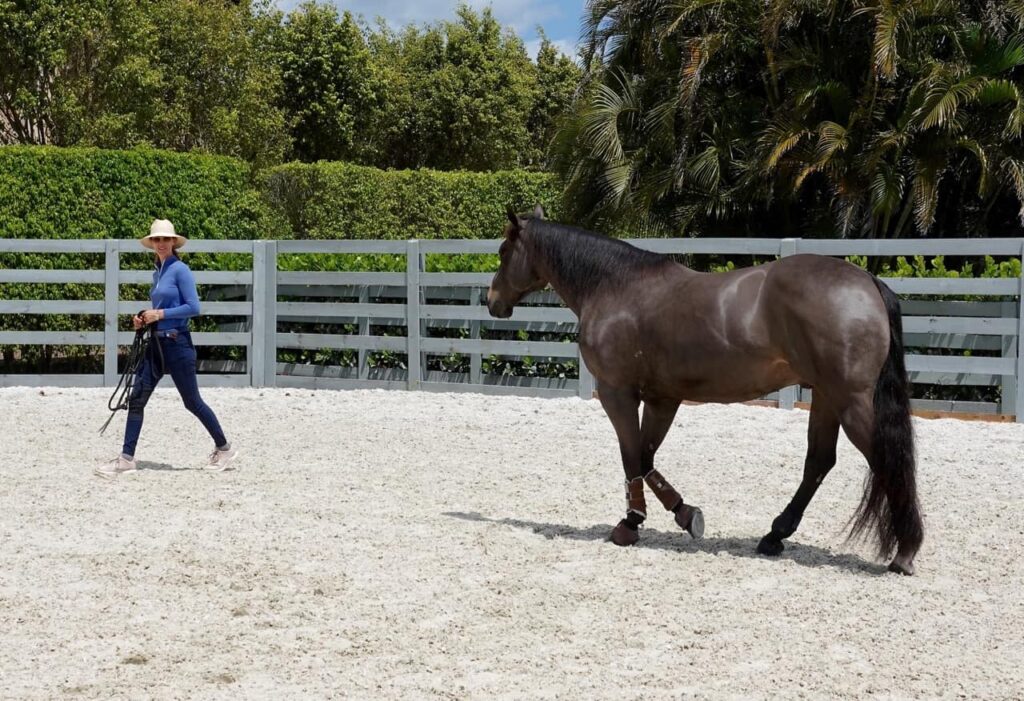
When he reaches me, I stand with him calmly, letting my body energy completely relax. I scratch his withers, praise him, and enjoy hanging out with him:
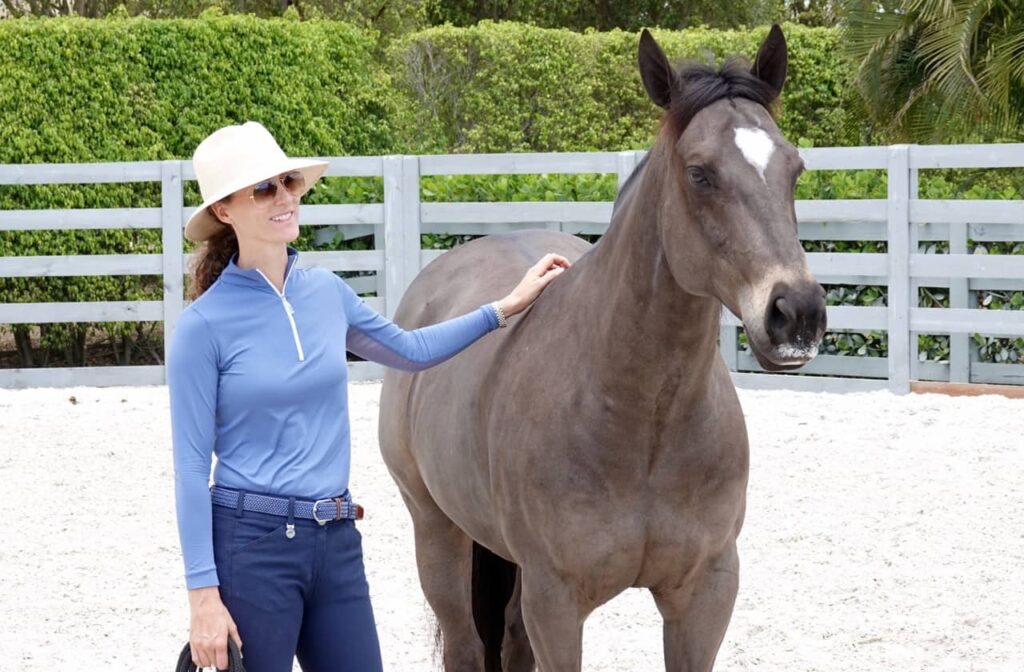
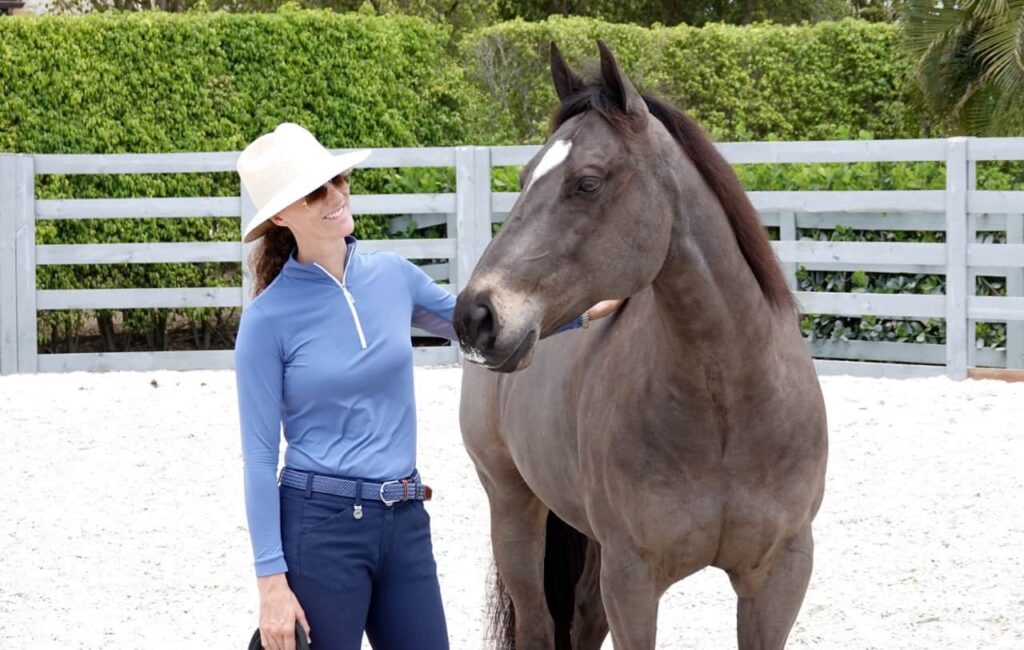
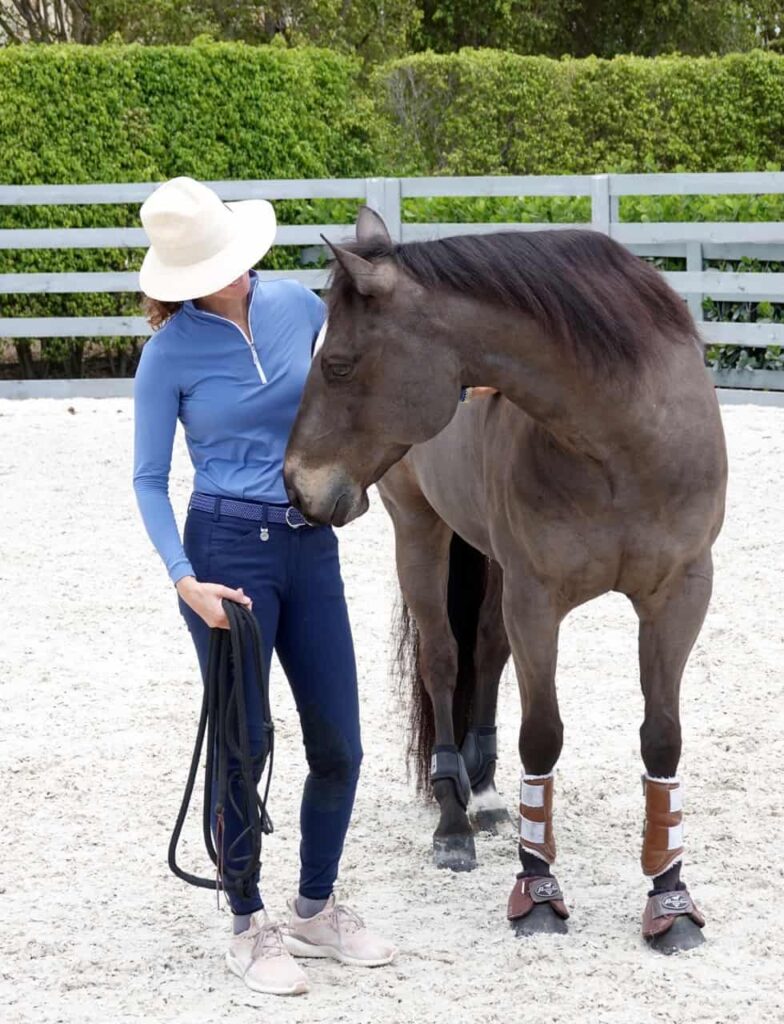
Then I ask him to follow me again, simply by looking toward his hindquarters and kissing to him. This time, he responds to those cues—much less pressure than before—and attaches:
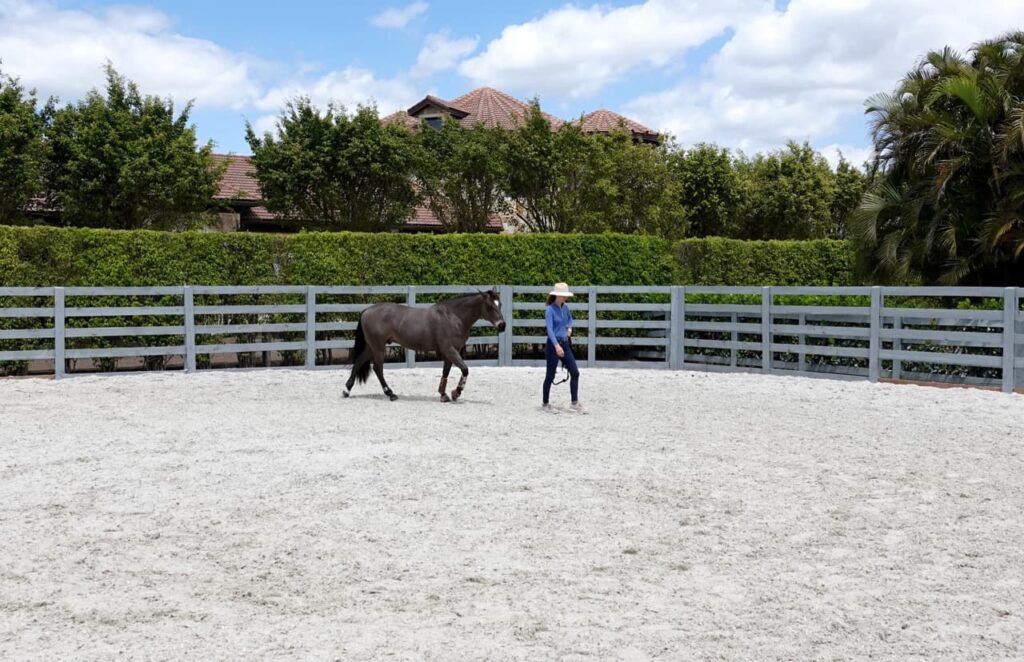

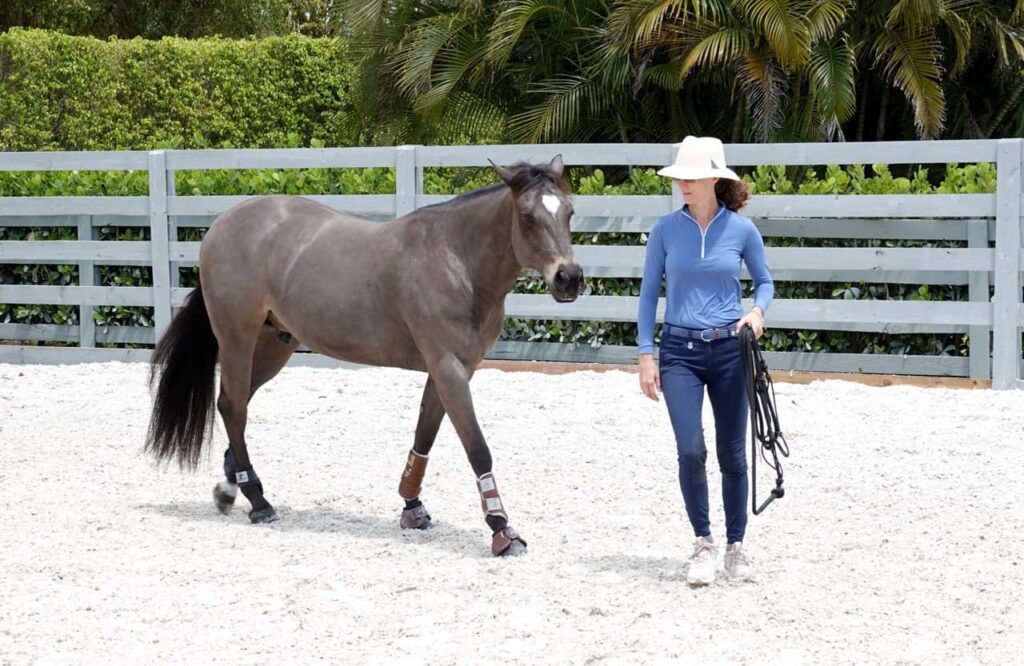
When his attention wanders, I simply notice and make the request again, using the least amount of pressure necessary:
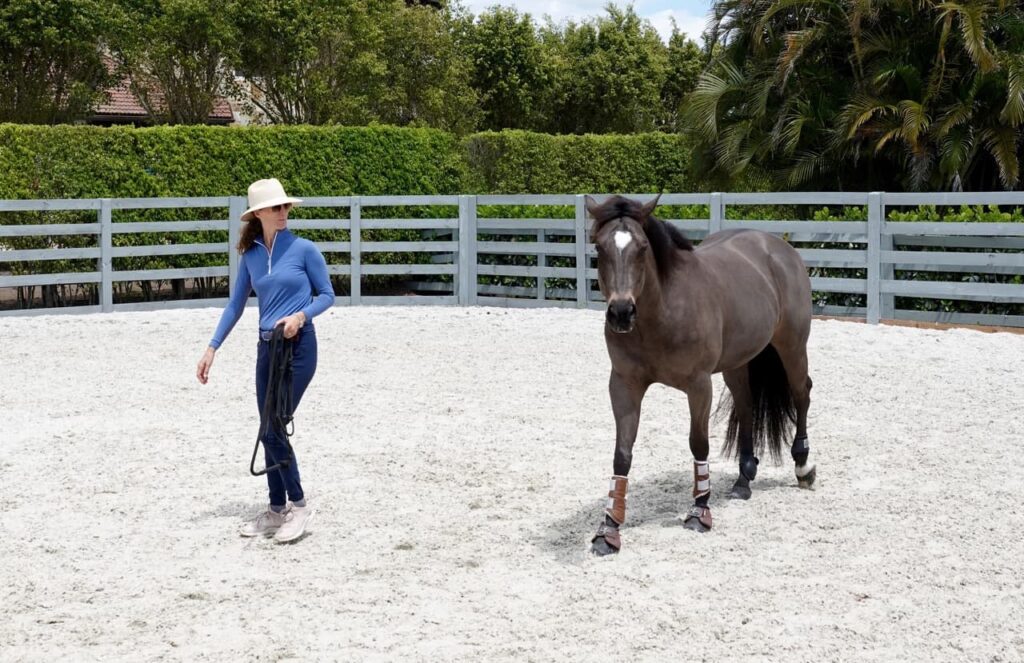
Again, he attaches, and we both enjoy the connection:
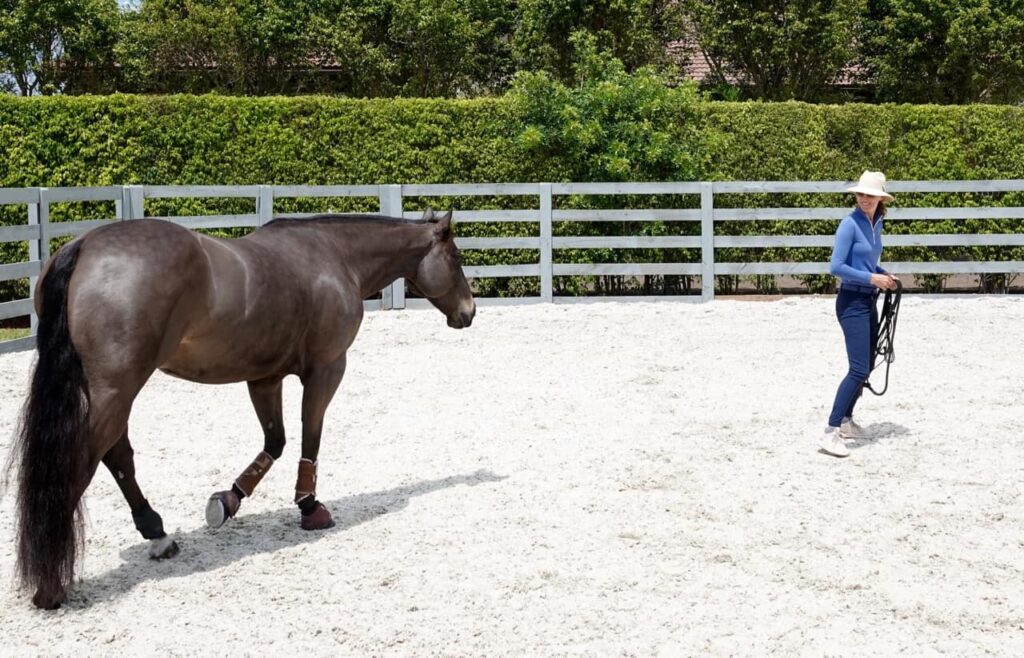
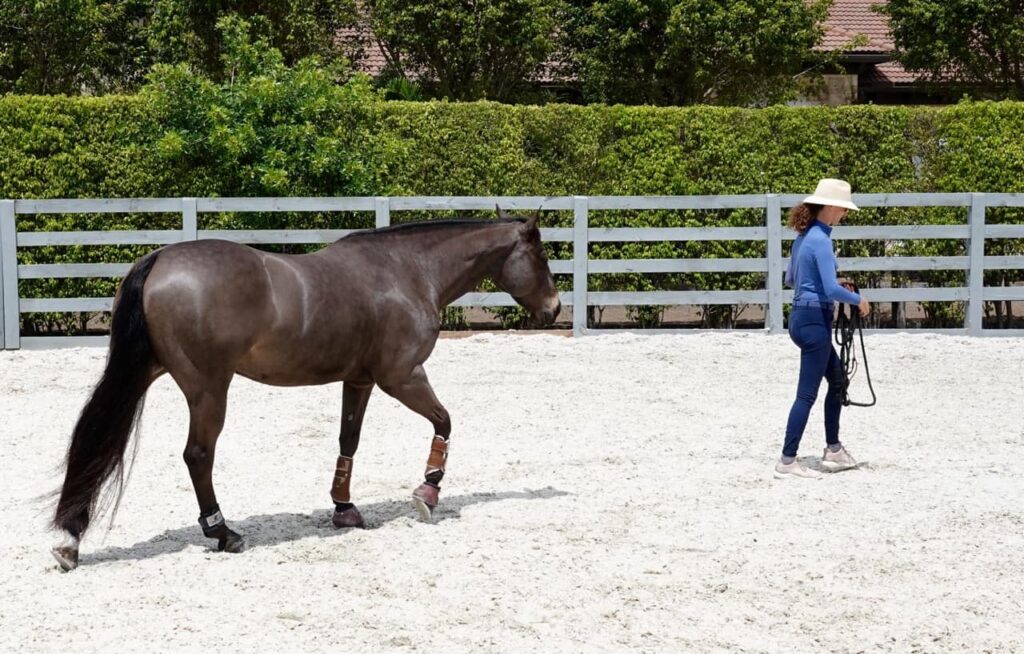
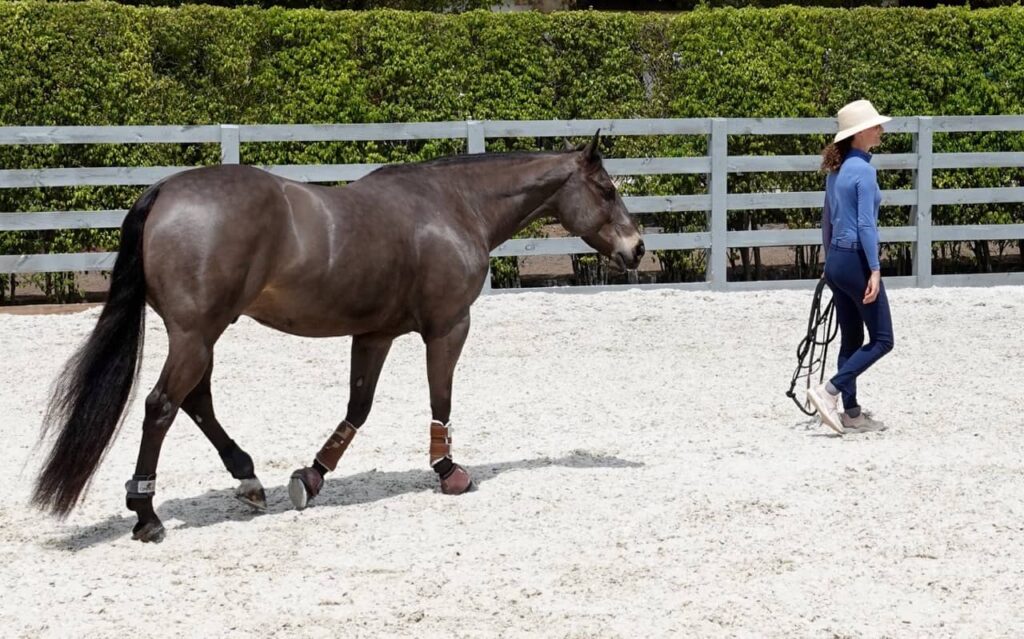
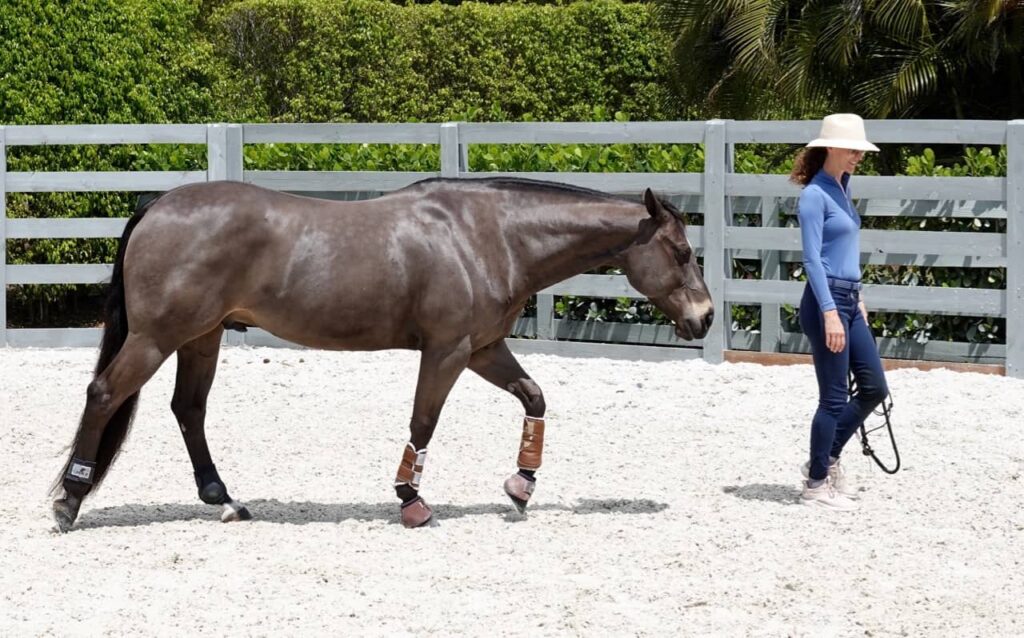
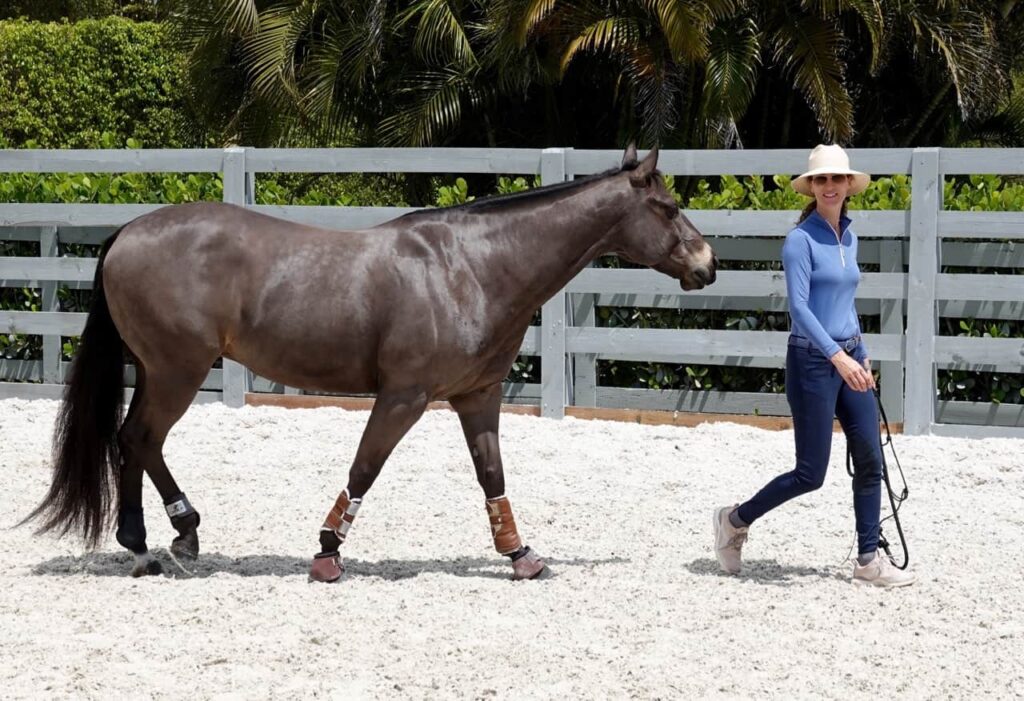
We finish by standing quietly together again. Even when he looks across the round pen, we’re still connected. He’s relaxed, not alarmed by whatever he sees, and he easily brings his attention back to me (notice the tilt of his ear in the second photo):
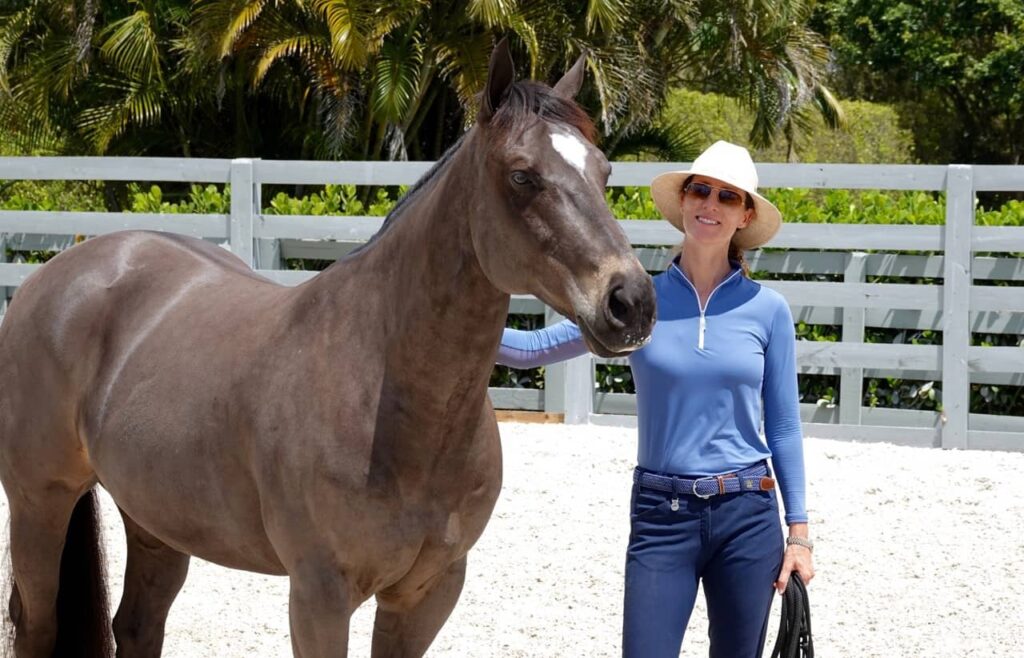
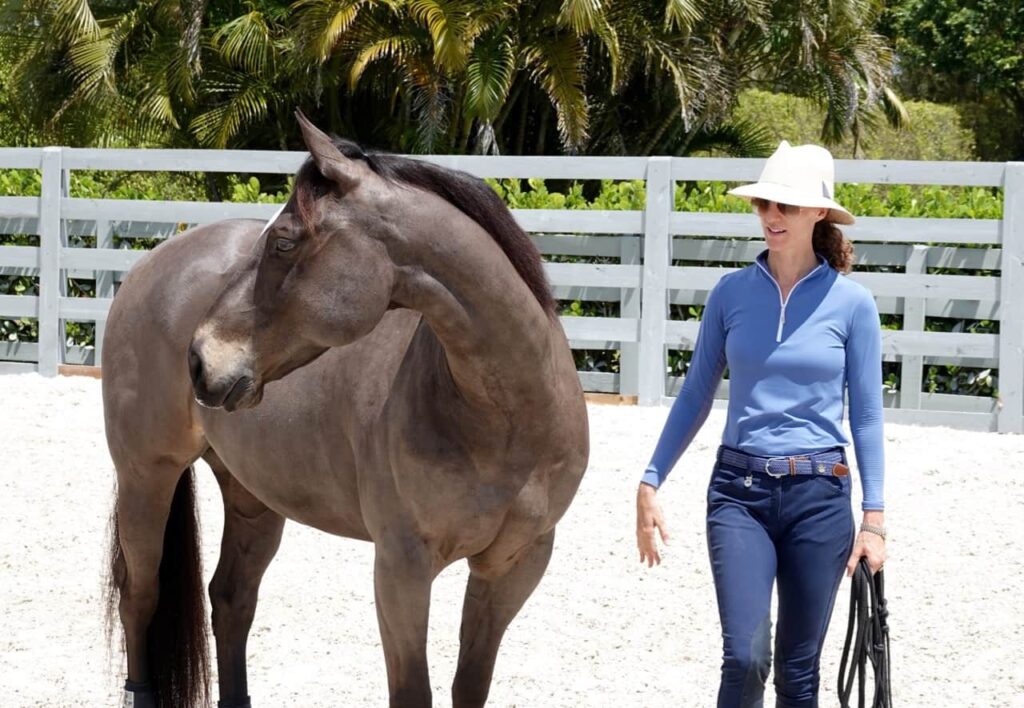
Photo series by my husband, Philip Richter
Horsemanship Insights
The legendary horseman Bill Steinkraus wrote, “Since the horse will have the last word in any case, we must try to ensure, through skill, tact, and moderation, that this last word is ‘yes.’”
Natural Lifemanship explains what that “skill, tact and moderation” consists of in its most evolved form: it’s about understanding the horse’s mind, including the neurobiology, in order to form a true partnership.
The very best compassionate horsemen might talk about leadership and submission (both Steinkraus and Sarah Dawson sometimes do, eg.) But in practice, the way they relate to their horses aligns closely with Natural Lifemanship principles. The best horsemen do create partnerships of mutual respect and trust. For them, this framework can provide some new language, a subtle shift in thinking, and a brain-based explanation for why their methods work. Plus maybe a few new tools and techniques, in the round pen and elsewhere.
In other cases, horse trainers could benefit from a major paradigm shift that encompasses not only their ideas but also their actions.
The Main Ideas
Submission should not be the goal. We do need to stop the horse from misbehaving because it’s not good for the relationship. But we don’t want the horse to be stuck in his lower, survival-based brain. We don’t want to dominate or control him; we want him to learn to appropriately control himself.
The most effective trainer neither coerces nor placates the horse. Instead, she uses well-timed pressure and release to have a conversation, with a goal of mutual understanding, trust, and connection. To succeed at this, she must be able to regulate her own internal state, in order to help the horse learn to regulate his. She does what’s right for the relationship, and the horse learns to do the same.
When horses learn to slow down, think, and freely choose to do the right thing, they become not only happier but better at their jobs, whether competing or trail-riding for pleasure.
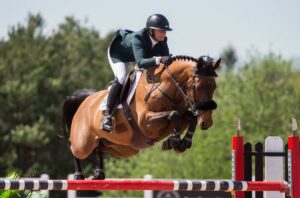
Connecting in Everyday Life
Although Natural Lifemanship arises from a framework of healing trauma, it can help everyone. We all benefit from enhanced self-awareness and self-regulation. We all benefit from relationship-building skills. Through this work, we can learn to stay calm and grounded when faced with challenge; to enjoy more fully those moments of connection with others, and to create the most fulfilling relationships possible with people and animals.
A Few Takeaways
Make connection the priority.
Whether talking with coworkers, walking your dog, or working out a disagreement with a family member, prioritize connection and you’ll get a much better outcome. Rather than fixating on issues, trying to control others, or insisting you’re right, try to connect. This approach leads to considerate listening and more genuine self-expression—which make for better immediate experiences and healthier relationships.
Plus, connection feels good; it cultivates wellbeing for yourself and those around you. As you go about your day, remember you can connect with others even in casual interactions.
Do what’s right for the relationship.
Let this principle guide you in your relationships with people and animals. Do what’s right for the relationship, and ask the other to do the same. This means you’ll communicate what you need and be aware of the other’s needs. You’ll make your own requests and listen to theirs.
Be aware of how much pressure you’re using.
When you communicate with others, be aware of how strongly you’re coming across. Think about what constitutes pressure in a given situation, and be mindful of how you apply it. Use the least amount of pressure necessary to get a response. And make sure you learn how to take the pressure off when you need to! (To learn more about this, you can attend a Natural Lifemanship Training.)
Cultivate your self-regulation.
In order to make use of these ideas, you need to be able to regulate your own system. Like well-traveled paths in the woods, the brain pathways we repeatedly use become our go-to reactions, while the ones we don’t use wither away. Notice your habitual thoughts and reactions. Learn to pause. You might make some subtle shifts that have a profound effect on how you feel and how you relate to others. A daily meditation practice can help.
Natural Lifemanship is both a science and an art. It helps us heal and evolve so that we can, in turn, have a positive impact on those around us. And the bottom line is, it just feels better when we live by these principles.
See more, and meet the horse-celebrity Grappa, at GrappaLane.com.
Find Natural Lifemanship trainings in your area.
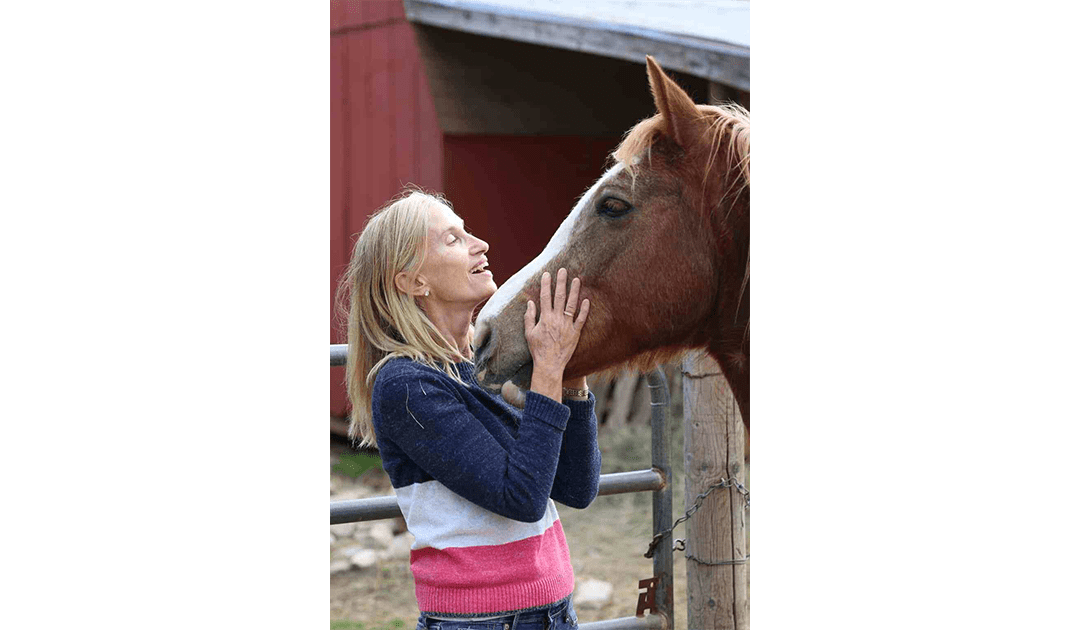
by Kathleen Choe | Feb 16, 2018 | Basics of Natural Lifemanship, Case Studies, Testimonials & Reflections
How Cross Brain Connections Literally Saved My Life!
In this blog, I will discuss how a healthy brain develops and how trauma impacts this process by localizing neural connections in the lower regions of the brain, the part concerned with survival. I will share ways we can capitalize on the brain’s neuroplasticity and capacity to heal with strategies to increase cross brain connectivity, ending with an example of this from my own personal experience of being assaulted on two different occasions.
There is a great deal of discussion in Trauma-Informed Care about cross brain connections, neural pathways that connect throughout the different areas of the brain, leading to a greater capacity for self-regulation and smooth emotional state shifting in response to environmental cues. Brain development begins in utero, developing sequentially from the bottom to the top and from the inside out in response to sensory input. The first part of the brain to develop is the brainstem, which is responsible for regulating autonomic functions like heart rate, breathing, blood pressure, body temperature, sleep, and appetite. We generally do not have to think about these functions unless something goes wrong with them (during an asthma or heart attack, for example). The brainstem, which as its name suggests, is at the base of the brain, is responsible for basic survival and is where our fight, flight and freeze responses originate in response to a trauma trigger.
The next region of the brain to develop is the diencephalon, which regulates motor control. (When the freeze response is triggered by the brainstem it indicates that the diencephalon, as well as all of the regions of the brain above it, have essentially gone “offline”). Following that is the limbic system, which regulates our emotions and makes us capable of attachment and relational connection. The last part of the brain to develop is the neocortex, which allows for abstract and concrete thought, impulse control, planning and other aspects of executive functioning. The neocortex may not be fully developed and functional until well into a person’s second decade of life.
Trauma can be defined as input that is arrhythmic and unpredictable. If a pregnancy is unwanted, or the mother is in a chaotic environment due to poverty and domestic violence, or she struggles with a mental disorder or uses drugs, for example, the fetus is exposed to a barrage of arrhythmic sensory input in the womb. The mother’s heart-rate may be irregular, the cadence of her voice may be harsh or distressed, and her body may be secreting stress chemicals like cortisol and adrenaline that acid washes the womb for nine months. The part of the brain that receives the most sensory input will be the most well developed, as the neurons flock there in response to continuous activation. A baby experiencing intra-uterine trauma of any sort will be born prepared for survival, with most of his or her neurons clustered in the lower regions of the brain. A baby whose gestation was full of rhythmic, predictable sensory input from his mother’s well-regulated heartbeat, calm voice, and soothing chemicals like dopamine, serotonin, and oxytocin, will be born with up to fifty percent of his neurons having migrated to the neocortex, ready for language and learning. Intra-uterine trauma primes the baby’s brain to form local connections in the lower regions of the brain in anticipation of being born into a chaotic, unpredictable environment. The foundation for future development is compromised, and any subsequent trauma layers on top of this shaky substrate to create a brain muscled up for survival and reactivity, with few cross brain connections allowing for a regulated, integrated response to environmental or relational stimuli.
Dr. Bruce Perry points out that trauma interferes with what he terms smooth “state shifting,” referring to the ability of the brain to communicate between all of its regions to come up with the best response to deal with the situation at hand. Healthy brain development allows a person to accurately interpret input and respond appropriately based on what is actually happening in the present. In the case of a car careening into your lane of traffic, the amygdala sounds the alarm in the limbic system, the diencephalon kicks in and prompts you to quickly maneuver out of the way, and the brainstem briefly shuts down unnecessary functions like digestion that would divert energy away from dealing with the crisis. The neocortex, which would unnecessarily delay the response time, essentially goes offline. Whether the car barreling towards you is a Mercedes or a Chevrolet is completely irrelevant to your survival. Determining the color, make or model of the vehicle occupies precious time and attention that keeps you in harm’s way longer than necessary and compromises your ability to keep yourself safe. When cross-brain connections are absent, and the different regions of the brain lack neural pathways to communicate efficiently, the array of responses a person has is limited. A traumatized individual might get stuck in his brainstem, lose access to his diencephalon, freeze, and be unable to turn the steering wheel, incurring a collision with the oncoming car.
This is essentially what happened to me when I was assaulted in my early 20’s in Golden Gate Park in San Francisco. I was using a public restroom when a man who apparently had been hiding in the stall next to mine burst under the dividing wall and attacked me. I completely froze. I could not move, cry out, or think of how to defend myself. I never reported the assault or pursued any kind of help afterward. I simply left it buried in my brainstem and used my already active eating disorder and dissociative pathways to cope. When I unexpectedly became pregnant with my first child three years later, I realized my unhealthy patterns were going to affect my baby in damaging ways. Facing the huge responsibility of carrying and then caring for a child provided the incentive I needed to pursue healing in so many areas of my life. Although I worked hard on my recovery, my very stubborn pathways for dissociating from strong emotions and avoiding what I perceived to be the dangers of intimacy remained strong.
When I discovered Natural Lifemanship, I knew these principles of relational connection and partnership were the missing pieces to my healing puzzle. I was initially dismayed to find how much I struggled to experience connection in the round pen with the horses, but as I kept practicing asking for attachment and detachment, I found over time that I was starting to feel my emotions and body sensations more consistently and accurately, both with horses and with people. Through both ground (Relationship Logic) and mounted work (Rhythmic Riding), I strengthened the cross brain connections necessary to stay regulated and grounded without checking out in stressful situations. My sense of peace and confidence and ability to stay present and connected to myself continued to grow.
Last year all of this was put to the test when I was out running in my neighborhood early in the morning. I heard footsteps behind me on a narrow stretch of sidewalk bordered by tall hedges and a railing on either side and turned sideways, thinking another runner wanted to pass me. Instead, he grabbed me by the shoulders, muttered the word “sorry” and threw me to the ground. My brain immediately went into gear. Just the night before I had shared a public service announcement from the Austin Police Department with my running group concerning a sexual predator who had been assaulting female runners. I could literally see the list of suggestions in my mind and began sorting through them. “Make noise,” my brain said, and I started screaming as loud as I could. My assailant covered my mouth with his hand. “Fight back,” my brain commanded, and I shook one of my arms free and tried to push him off. As he tightened his grip, I remembered, “Strike where he is most vulnerable,” so I started reaching towards his groin area as best as I could. His eyes widened in surprise and he suddenly let go of me, slamming my head into the pavement. I don’t know how long I lost consciousness, but as I came to, I heard a voice shouting, “Get up! Get up! You have to get up NOW!” I realized the voice was my own; it was my brain, telling me I needed to mobilize in case he came back. I was able to get up and wobble up the hill until I met another runner who took me to her house and called 911.
I reported this assault. I went to the emergency room, made a statement to the police, and described the suspect to a forensic artist who captured his likeness quite accurately. I engaged in therapy, and spent hours in the round pen with horses, crying, connecting, and healing. I shared my experience with my running group and put together a tip sheet for runner safety, which I shared with other running groups in the area. I attended a self-defense class. Despite the temptation to revert to old patterns of dissociating from my fear and pain, I practiced feeling all the emotions in the aftermath of this trauma, letting myself weep when the detective called to say my suspect’s DNA was found on another victim. I gave myself permission to be scared, sad, and also proud. Proud that I had done the hard work to develop the cross brain connections that allowed me to fight back instead of freezing during my second assault. During my therapy for this attack, I was able to process my first one as well.
Cross brain connections are essential for flexible thinking and appropriate responses. Practicing mindfulness and grounding skills on a regular basis allows these neural pathways to develop and strengthen in a brain compromised by arrhythmic, unpredictable input. Research continues to highlight the neuroplasticity of the brain in response to rhythmic sensory input that allows it to heal and integrate following trauma. Expanding local connections into cross brain connections enhances our ability to experience emotional regulation so that we can build healthier, more satisfying relationships with ourselves and with others.
How does one build or repair cross brain connections?
A daily practice of mindfulness (meditation, yoga, or centering prayer, for example) has been shown to improve brain connection and functioning. Exposure to reparative or corrective relational experiences also contributes to building neural pathways from the lower to the upper regions of the brain. Trauma victims often repeat dysfunctional patterns in the relationship due to compromised neural connections in the brain, reinforcing their trauma pathways. Equine Assisted Psychotherapy involves partnering with a horse to provide opportunities for new pathways to form a healthy relationship is built between horse and human under the guidance of a therapist and equine specialist. Clients learn how to build and sustain healthier relationship patterns as their brains literally re-wire through the experiential component of the therapeutic work with the horses. Through a combination of ground and mounted work, a person can learn self-regulation skills, positive coping resources, and begin to heal from their trauma.
What are cross brain connections good for? At some point, they just might save your life.
For more information, check out the following website: naturallifemanship.com
*Dr. Daniel Siegel’s Wheel of Awareness is an excellent resource for developing such a practice, as is St. Michael’s Hospital Awareness Stabilization Training.
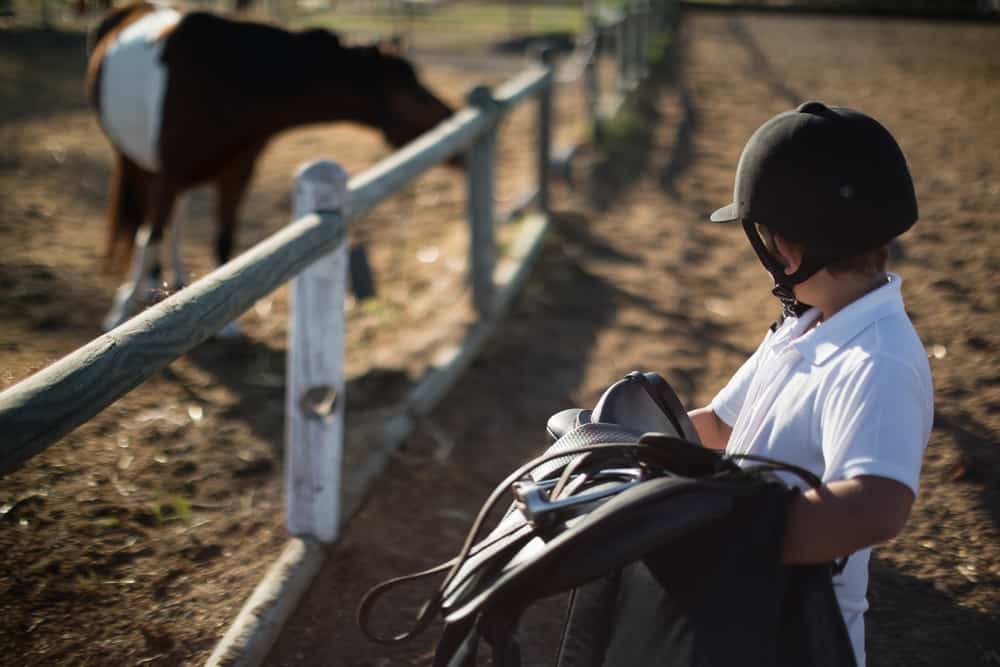
by Greer Swiatek | Jan 10, 2018 | Case Studies
Case Study About a Boy Seeking Connection
Oliver was sitting in a stall with Banjo, holding a saddle close to his chest, slumped over in defeat. It was yet another session that he tried to ride Banjo and failed. The Equine Professional and I stayed connected with Oliver, guiding him through self-regulation exercises and resisting the urge to rescue him or provide detailed instructions. Oliver wanted us to provide direction and he became frustrated at times when we encouraged him to find his own path to connecting with Banjo. Banjo stood beside him, patiently waiting and breathing slowly. Oliver continued to hug the saddle and his eyes seemed to glaze over at times like he was a thousand miles away. Banjo stomped one hoof, then another. Oliver blinked a few times and looked at him. Oliver started to check out again, but not for long. Banjo continued to make the request for him to stay present, using body movement and breath to get Oliver’s attention. Banjo was consistent and they continued this back and forth interaction until Oliver became calm and fully present. Oliver tilted his head and stared at Banjo with a gleam in his eye, a slow smile appeared on his face. It was in that moment, while sitting in the corner of the stall, that hot summer day, that something shifted in Oliver. He dropped the saddle, took a big belly breath and realized that this relationship was going to be different…it had to be different.
Oliver’s chronic anxiety led to an environment where his family managed almost every aspect of his life. He had little independence. At 12 years old, he was sleeping in his parent’s bed with the overhead light left on. Oliver was afraid of the dark, among other things. With peers, he tended to be controlling and confrontational; he struggled with reciprocity in play. During our intake session, Oliver hid behind his mother, continuously rolling his eyes, speaking in a goofy voice, and laughing nervously after everything he said. He avoided eye contact and deflected direct interaction. His parents answered questions for him. When we redirected our attention to Oliver, he appeared startled and confused, like he had just woken up.
After picking Banjo that first day, Oliver walked, almost stomped, directly to the barn. We had to jog a bit just to keep up with him. He told us he wanted to ride Banjo and looked at us expectantly. The Equine Professional and I paused and looked at each other to check in, communicating non-verbally that we were on the same page. We knew that if we intervened and said “no”, we would be setting the tone for the therapeutic relationship going forward, one of power and control. Instead, we trusted the process, we trusted ourselves, and we relied on Natural Lifemanship Principles. We communicated to Oliver that only he could decide what was best for his relationship with Banjo. Over the next several sessions, Oliver and Banjo danced. Oliver moved forward with the saddle and Banjo moved away. At times Oliver was able to self-regulate, opening himself up for connection. In these moments, Banjo moved closer to him. Oliver got excited, quickly grabbed the saddle and marched over to meet Banjo. Banjo immediately backed away. Eventually, Oliver realized that his agenda to ride was taking him further away from what he desired most, connection.
Oliver then chose to move from the barn to the round pen to work on his connection with Banjo. He often began sessions by pacing around the perimeter of the round pen, pulling weeds and throwing them out of the round pen like a baseball. At first, this startled Banjo, but Banjo continued to be patient and cautious. Picking and throwing weeds was a regulating activity for Oliver that allowed him to connect with himself. His connection with-in opened the door for connection with Banjo…Banjo began to follow Oliver, stopping when he stopped to pick up another weed and launch it outside the round pen. Oliver would then continue to walk and Banjo would follow. At times, Oliver would run around the round pen and request Banjo to follow him. Banjo is an older horse and preferred to walk. Oliver was able to stay connected and realize that Banjo had some requests of his own. Their connection grew stronger. At times, Oliver’s mind would wander while he walked, Banjo would gently nudge him in the shoulder to help him stay present. Oliver found his own way to regulate and connect, by pulling and throwing weeds. This was more powerful than anything we could have suggested because it came from within. It was a reminder to keep the process client-led and provide a space for our clients to experiment and explore.
One day, Oliver came to session after a particularly hard day at school. He was having trouble regulating himself and asked for our help as he sat in the middle of the round pen. I asked Oliver to lie down on the ground and close his eyes while the Equine Professional put Banjo on a lead rope. Oliver became attuned to his breath and the ground beneath him, engaging the lower regions of his brain. We then asked him to bring his awareness to Banjo, bringing his limbic system online. The Equine Professional walked with Banjo around the pen while Oliver kept his eyes closed and tapped into his other senses to locate Banjo. Oliver was engaging in bottom-up regulation. He then used his neocortex to problem solve where Banjo was in the round pen while continuing to regulate the lower regions of his brain by rhythmically rocking back and forth. While his eyes were still closed, Oliver made a request for connection. He wanted Banjo to stop eating grass and to come to greet him in the center of the pen. The Equine Professional dropped the lead rope. We asked Oliver to imagine what it would look and feel like for Banjo to approach him while keeping his eyes closed. “Well, he would take one step forward….then he would eat a little more grass…then take another step forward…then another step” Oliver replied.
Banjo began to slowly approach Oliver, one step at a time while continuing to enjoy the delicious grass beneath him. Oliver became a little impatient. He took a big belly breath and said, “I wish he would just hurry up”. Banjo immediately pulled his head up from grazing and quickly walked over to Oliver, nuzzling his hair when he reached him. Oliver opened his eyes and laughed in pure joy.
Oliver was building pathways in his brain for a new way of interacting with others and began to employ a whole-brain understanding that true connection comes from within.































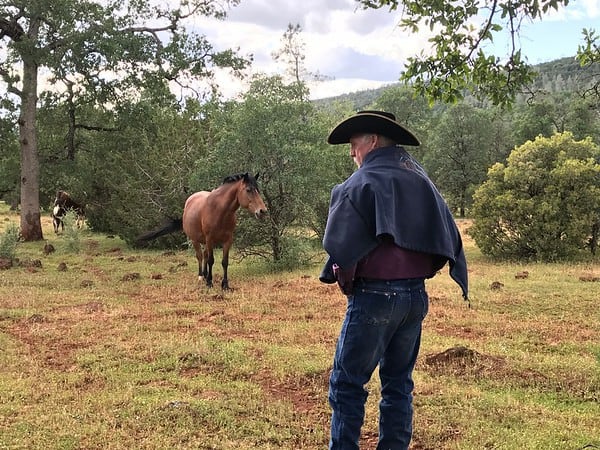


Recent Comments